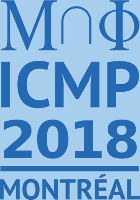String Theory & Quantum Gravity
- Eric D'Hoker (UCLA Physics & Astronomy)
- Duong Phong (Columbia University)
- Thursday, Jul 26 [symposia auditorium]
- 14:00 Ken Intriligator (University of California), Aspects of Symmetry and RG Flow Constraints
- 14:30 Eva Silverstein (Stanford University), Toward a phase diagram for longitudinal string interactions
- 15:00 Boris Pioline (Université Pierre et Marie Curie), Exact effective interactions in string vacua with 16 supercharges
- 15:30 Jeff Harvey (Enrico Fermi Institute), Hecke Relations in Rational Conformal Field Theory
- Friday, Jul 27 [symposia auditorium]
- 15:15 Shamit Kachru (Stanford University), Black holes, class numbers, and special cycles
- 15:45 Sergei Gukov (California Institute of Technology), Dualities and Topology
- Ken Intriligator
University of CaliforniaAspects of Symmetry and RG Flow ConstraintsI will discuss joint work with Cordova and Dumitrescu on aspects of various symmetries and associated constraints on RG flows. The symmetries include supersymmetry and conformal symmetry, and the constraints include 't Hooft anomaly matching. I will especially discuss the case of 2-group symmetry, with examples in four and six spacetime dimensions.
- Eva Silverstein
Stanford UniversityToward a phase diagram for longitudinal string interactionsStrings interact over a range that grows linearly with energy in the longitudinal direction of relative motion between them. This leads to contributions to scattering and black hole mining that go beyond effective field theory, as a result of the large non-local energy invariant near black hole horizons. In this talk, we summarize this and explain new calculations of the timescale for this effect, incorporating the string spreading effects in the Eikonal resummation as well as generalizing to include inelastic and inclusive processes.
- Boris Pioline
Université Pierre et Marie CurieExact effective interactions in string vacua with 16 superchargesIn string vacua with extended supersymmetry, some of the terms in the low energy effective action can often be determined exactly by combining constraints from supersymmetry, duality, and information from perturbative string theory. The analysis of these exact results near boundaries of the moduli space can then reveal valuable information about non-perturbative effects in string theory. I will apply this strategy to four- and six-derivative interactions in string vacua with 16 supersymmetries in D=2+1, and obtain the detailed spectrum of BPS black holes in D=3+1 via a study of the decompactification limit. Based on work with G. Bossard and C. Cosnier-Horeau.
- Jeff Harvey
Enrico Fermi InstituteHecke Relations in Rational Conformal Field TheoryHecke operators that act on characters of rational conformal field theories are defined and we use these to show that many RCFT characters are related by Hecke operators. These relations extend the previously studied Galois symmetry of the modular representations appearing in RCFT. Connections with modular linear differential equations will also be discussed.
- Shamit Kachru
Stanford UniversityBlack holes, class numbers, and special cyclesWe discuss a relationship between BPS black holes in string theory compactification on K3 x T2, and class numbers of quadratic imaginary number fields. This connection explains the fact that inequivalent “attractor black holes” in this string model are counted by coefficients of the q-series of a weight 3/2 mock modular form. These facts constitute a special case of a more general relationship between special cycles in string theory moduli spaces and automorphic forms which count them, arising from the theory of Kudla and Milson.


